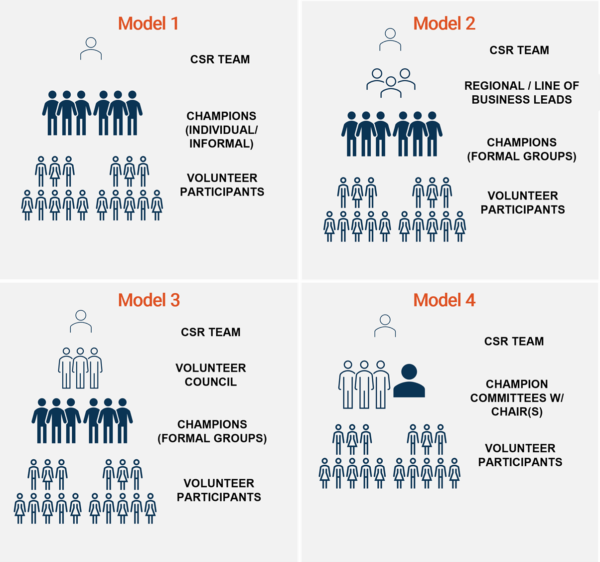A few months ago, I was running a client workshop where we were defining new responsibilities for volunteer leaders at the company. After talking for a while about what volunteer leaders could do for “the community” someone piped up and said, “What do we even mean by community, though? Doesn’t that look different for different people?” And I thought that was a very good, and indeed beautiful, question. Because community is complex. Community is its own system. Communities come in many shapes and sizes, and they are everywhere. And CSR practitioners are often focused so heavily on external communities that they can lose touch with the community right in front of them – their volunteer leaders.
Building volunteer leader networks is a core part of what we do at Realized Worth: we help practitioners find, recruit, and equip corporate volunteers to run Transformative social impact experiences for their peers. But our field is also at a point now where almost every company we work with already has a volunteer leader network. So, our work has in many cases become not just building volunteer leader networks but evolving them – improving them. And without a doubt the most common problem we encounter when doing this work is that practitioners aren’t viewing their network of volunteer leaders as a community. They’re looking at this group of highly motivated people with a shared desire to help improve society as a means to an end. “How do I get higher engagement scores? How do I get more volunteer hours? How do I get more participation?”
These aren’t the questions you should be asking.
Here’s the thing about communities – they’re people-centric: “Members of a community have a sense of trust, belonging, safety, and caring for each other. They have an individual and collective sense that they can, as part of that community, influence their environments and each other.” Community “[…] is not a place, a building, or an organization […]. Community is both a feeling and a set of relationships among people. People form and maintain communities to meet common needs.”
So, how can you nurture your network? How do you create and cultivate a community of volunteer leaders?
I love this statement: “Community is both a feeling and a set of relationships among people. People form and maintain communities to meet common needs.” This is what practitioners should focus on when it comes to a volunteer network: A governance structure, communication systems, and learning resources all designed to create a feeling of belonging, safety, trust, mutual care, connection, and collaboration, all with a shared future in mind. Let’s dive into these elements.
1. Governance Structure
How volunteers are organized changes how they collaborate and learn from one another. The shape of your volunteer network will change how knowledge is shared, how understanding of goals and priorities is disseminated, how people connect and who they connect with. Below are only four examples of the different shapes governance can take (and you can pull elements from one model into others depending on what you want to achieve). None of these models are necessarily “better” than the other, but they do have to align with the maturity of your programs, the readiness for change within the business and with employee volunteer leaders, and with your capacity as a practitioner to manage at a strategic and people level as you shift towards a network that can manage itself autonomously.

2. Communication Systems
This element of a volunteer network is the most overlooked, often because practitioners are under-resourced when it comes to all things communication. That said, creating intentional ways for the various layers of a network to connect and learn from one another will look different. For example, if you have a committee model (Model 4), you’re creating communications guidance between the Chairs and CSR team, the Chairs and the committee members, the committee members, and the Volunteer participants. This can be anything from monthly to quarterly meetings to celebration calls, to strategic planning and goal setting calls. These types of connection points will look different for, for example, a council model vs. a committee model – and the cadence and content will differ based on the goals and culture of your business. In addition to these types of communication systems, practitioners should also consider:
- Digital communication: Where and how is your volunteer leader network connecting in digital spaces? There’s Slack and Yammer for more informal/casual communication and ongoing updates, but what do your intranet offerings look like? Is there a hub where volunteers can go to find resources, stories, and to ask questions and connect with other volunteers across the business? How is this connected with your volunteering and giving platform?
- Storytelling: How are you equipping volunteer leaders to share stories in an intentional way? Are you deputizing someone on a committee or within a group of volunteers? Are you connecting them with a local communications person? Do they know about social media guidelines, do they have access to templates that make it easy to share?
- Communication with managers and leaders: How are you making it easy for volunteer leaders to bring managers and leaders into the loop – to understand, advocate for, model and celebrate community engagement? What training or templates are you providing to equip them? What guidance are you providing so they can integrate this type of activity into their regular duties?
3. Learning resources
Out of all the categories we’ve outlined, your learning resources are one of the most powerful ways you can cultivate a community of volunteers. This is because appropriate training and assets enhance competency, collaboration & belonging, and autonomy for different roles. This means providing appropriate training and assets to volunteer leaders who have more of a focus on the strategic (i.e., goal setting, volunteer management, volunteer engagement at business unit/regional levels) versus volunteer leaders who are more focused on activation (i.e., planning and running volunteering, giving, and civic action projects). Let’s look at indicators of competency, collaboration & belonging, and autonomy:
Competency
- Volunteers know their role responsibilities and what’s expected of them.
- Volunteers understand and can articulate how their actions ladder up into the company’s overarching social impact and business goals.
- Volunteers feel like experts in their roles and are willing to pass knowledge on to others or engage others to participate regularly.
Collaboration and Belonging
- Different types of volunteers (strategically-focused [SF], activation-focused [AF]) know how to connect regularly to learn from one another and share knowledge – there is both mentorship (SF to AF) and peer-to-peer knowledge sharing (SF to SF, AF to AF, SF to AF).
- Volunteers regularly share personal and professional values with one another and are encouraged to explore how those values align with the business’s approach to social impact and overarching business objectives.
- Volunteers feel a sense of belonging (the below are adapted from the Wheaton College model of belonging):
- Volunteers choose (or would choose) to stay in the network over time: People choose to be in relationship with one another. Actively choosing to stay (not a feeling of being “voluntold”) and to maintain relationships within the network indicates mutuality (respect, care, alignment) between volunteer leaders.
- Volunteers are invested in the network:
Volunteers feel welcomed, known, and cared for in a way that honors their identities and values. This is usually exemplified by high levels of engagement in network activities and with other volunteers. - Volunteers have strong relationships with other volunteers: Volunteers feel as if their needs are being met by other volunteers in the network – they feel supported, safe, and accepted.
- Volunteers are transformed by their experiences in the network: Volunteers feel as if they have grown in significant ways through interactions, knowledge sharing, mentorship, and collaboration with other volunteers.
Autonomy
- Volunteers make strategic decisions amongst themselves at the business unit/regional level with little to no input from the practitioner.
- Volunteers (with provided assets) actively set and track against goals at the business unit/regional level with little to no input from the practitioner.
- Volunteers are innovating – they are coming up with ways to message and model the value of the program with little to no input from the practitioner.
- Volunteers are agitating – they push the practitioner to improve strategic approach, processes, or systems.
- Volunteers are actively collaborating with one another at the business unit/regional level with little to no management from the practitioner.
If you aren’t nurturing your Volunteer Leader Network, you’re missing out on a big opportunity. Creating and cultivating a community of leaders is key to a successful volunteer program, yes, but also to your own career and development. When you empower your leaders with a solid foundation, a sense of community, and the right tools, you are also creating the space to elevate yourself. This work is hard, we know, but you don’t have to do it alone – Social REV has plenty of resources to help you build, improve, and elevate your Volunteer Leader Network (and anything else you might need a hand with). When you’re ready to join, say the word. Let’s unlock the full potential of your Volunteer Leader Network.






